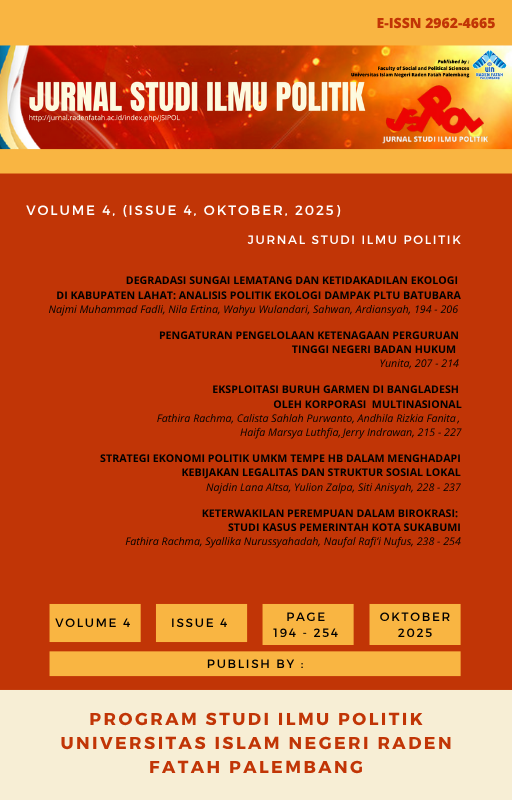Keterwakilan Perempuan dalam Birokrasi: Studi Kasus Pemerintah Kota Sukabumi
Main Article Content
Abstract
This study explores the representation of women in the bureaucracy of Sukabumi City, focusing on the persistent gender gap in strategic positions. Despite the existence of affirmative policies requiring a 30 percent quota for women in decision-making roles, their representation remains disproportionately low, especially in structural levels such as echelon II and III. Using a qualitative descriptive approach with literature study as the primary method, this research identifies structural, cultural, and personal factors that collectively form a glass ceiling for women in public service. Findings reveal that gender-biased promotion systems, patriarchal organizational culture, limited access to leadership training, and a lack of female mentorship significantly hinder women's advancement. The study emphasizes the need for gender-sensitive meritocracy reforms and sustained leadership development initiatives to foster inclusive governance. Ultimately, increasing women's representation is not merely a matter of fulfilling quotas, but a strategic step to enhance bureaucratic quality, social equity, and policy responsiveness.
Downloads
Article Details

This work is licensed under a Creative Commons Attribution-ShareAlike 4.0 International License.
Authors who publish with this journal agree to the following terms:
- Authors retain copyright and grant the journal right of first publication with the work simultaneously licensed under a Creative Commons Attribution License that allows others to share the work with an acknowledgement of the work's authorship and initial publication in this journal.
- Authors are able to enter into separate, additional contractual arrangements for the non-exclusive distribution of the journal's published version of the work (e.g., post it to an institutional repository or publish it in a book), with an acknowledgement of its initial publication in this journal.
- Authors are permitted and encouraged to post their work online (e.g., in institutional repositories or on their website) prior to and during the submission process, as it can lead to productive exchanges, as well as earlier and greater citation of published work
How to Cite
References
Adriani, S., & Maulia, S. T. (2024). Partisipasi perempuan dalam politik. Journal of Practice Learning and Educational Development, 4(2), 131–136.
Adriardi, D. A. (2024). Stereotip gender dan konstruksi kepemimpinan perempuan di lembaga publik. Jurnal Kepemimpinan Gender dan Inklusi, 3(1), 22–35.
Badan Kepegawaian dan Pengembangan Sumber Daya Manusia (BKPSDM) Kota Sukabumi. (2019). Data distribusi jabatan ASN berdasarkan gender. Sukabumi: BKPSDM.
Badan Pusat Statistik (BPS) Kabupaten Sukabumi. (2019). Statistik Aparatur Sipil Negara Kabupaten Sukabumi. Sukabumi: BPS.
Braun, V., & Clarke, V. (2006). Using thematic analysis in psychology. Qualitative Research in Psychology, 3(2), 77–101. https://www.researchgate.net/publication/235356393
Febriyanti, A., Putri, A. G., Kanti, Y. S., & Ummah, A. (2022). Keterwakilan perempuan di birokrasi: Fenomena glass ceiling pada kementerian Republik Indonesia. Jurnal Administrasi dan Kebijakan Publik, 9(1), 45–60.
Febriyanti, A., Putri, A. G., Kanti, Y. S., & Ummah, A. (2022). Keterwakilan perempuan di birokrasi: Fenomena glass ceiling pada kementerian Republik Indonesia. Jurnal Politik dan Pemerintahan, 7(2), 134–148.
Handayani, L., & Suryani, T. (2020). Hambatan struktural perempuan dalam birokrasi publik. Jurnal Administrasi dan Kebijakan Publik, 5(1), 45–58.
Handayani, S., & Suryani, A. (2020). Perempuan ASN dan hambatan promosi jabatan. Jurnal Administrasi Negara, 10(1), 70–84.
Infopublik. (2023). Lingkungan kerja ramah gender masih minim di instansi pemerintah. Kementerian Komunikasi dan Informatika Republik Indonesia. https://infopublik.id
Johns, M. L. (2013). Breaking the glass ceiling: Structural, cultural, and organizational barriers preventing women from achieving senior and executive positions. Perspectives in Health Information Management. https://www.ncbi.nlm.nih.gov/pmc/articles/PMC4172170/
Kartikasari, D., & Wulandari, A. (2021). Evaluasi kebijakan kesetaraan gender dalam promosi jabatan ASN perempuan. Jurnal Gender dan Pembangunan, 6(2), 110–123.
Kartikasari, D., & Wulandari, F. (2021). Gender and leadership in local government bureaucracy. Journal of Regional Governance, 14(3), 150–168.
Kementerian Pendayagunaan Aparatur Negara dan Reformasi Birokrasi (PAN-RB). (2023). Laporan tahunan reformasi birokrasi dan kinerja ASN. Jakarta: KemenPAN-RB.
Kurniawati, H., & Rakhmani, I. (2020). Gender dan partisipasi perempuan dalam pengambilan keputusan publik: Studi kasus perempuan pemimpin di tingkat lokal. Jurnal Masyarakat dan Budaya, 22(2), 115–130.
Kurniawati, I., & Rakhmani, I. (2020). Women leaders in local bureaucracy: Evidence from Indonesia. Journal of Southeast Asian Politics, 25(4), 300–315.
Lestari, N. D. (2004). Budaya patriarki dan pengaruhnya terhadap peran perempuan di ranah publik. Jakarta: LKiS.
Lestari, Y. (2008). Persepsi dan partisipasi anggota DPRD Propinsi Daerah Istimewa Yogyakarta terhadap kesetaraan gender (Tesis Doktoral, Program Pascasarjana Universitas Diponegoro).
Moleong, L. J. (2017). Metodologi penelitian kualitatif. Bandung: Remaja Rosdakarya.
Murthi, Y. H. (2017). Mewujudkan kesetaraan gender: Panduan teknis Goal 5 SDGs untuk pemerintah daerah dan pemangku kepentingan daerah. Jakarta: International NGO Forum on Indonesia Development (INFID).
Nugroho, R. (2002). Kualitas kesetaraan gender dalam administrasi publik Indonesia: Evaluasi pada kebijakan organisasi, pendidikan dan mekanisme. Universitas Gadjah Mada.
Nugroho, R. (2008). Public policy: Dinamika kebijakan, analisis kebijakan, manajemen kebijakan. Jakarta: Elex Media Komputindo.
Nurhadi, A., & Riyanti, F. (2021). Meritokrasi dan ketimpangan gender dalam birokrasi publik Indonesia. Jurnal Administrasi Publik Indonesia, 8(1), 65–79.
Nurhadi, M., & Riyanti, A. (2021). Gender sensitivity in bureaucratic meritocracy. Jurnal Ilmu Pemerintahan, 13(1), 89–102.
Putri, R., & Setiawan, A. (2020). Female bureaucrats and leadership confidence in Indonesia. Journal of Public Sector Management, 12(2), 33–47.
Putri, S. A., & Setiawan, B. (2020). Persepsi kepemimpinan perempuan di sektor publik: Antara kepercayaan diri dan representasi. Jurnal Kepemimpinan dan Inovasi Publik, 8(1), 22–35.
Reiners, B. (2023). Breaking the glass ceiling: Gender inequality in the public sector. Journal of Public Management, 15(2), 100–115.
Reiners, B. (2023). What is the glass ceiling? Definition, causes and examples. TechTarget. https://www.techtarget.com/whatis/definition/glass-ceiling
Sapri, H. (2024). Relasi patronase dan ketimpangan gender dalam promosi jabatan PNS. Jurnal Administrasi dan Kebijakan Publik, 10(2), 51–65.
UN Women. (2020). Women in public administration and leadership: Global status report. New York: UN Women. https://www.unwomen.org
Yin, R. K. (2003). Case study research: Design and methods (3rd ed.). Thousand Oaks, CA: Sage.
Zed, M. (2008). Metode penelitian kepustakaan. Jakarta: Yayasan Obor Indonesia.

